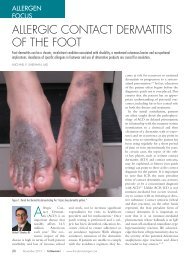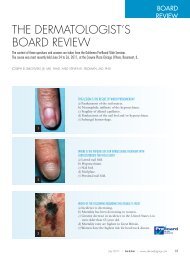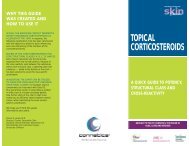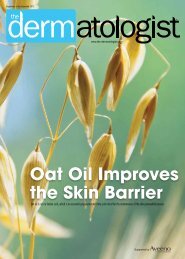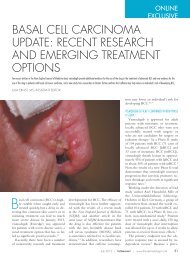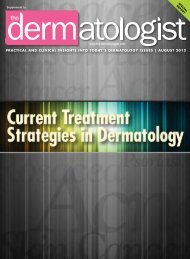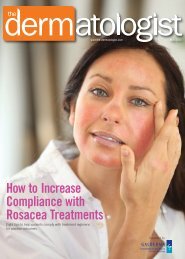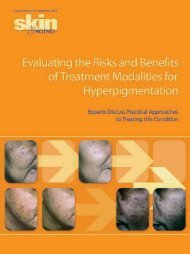Download PDF - The Dermatologist
Download PDF - The Dermatologist
Download PDF - The Dermatologist
You also want an ePaper? Increase the reach of your titles
YUMPU automatically turns print PDFs into web optimized ePapers that Google loves.
FA L L C L I N I C A L D E R M AT O L O G Y C O N F E R E N C E P R O C E E D I N G S<br />
ly superior efficacy in some cases, as compared to some older<br />
formulations (F i g u re 6). A “triple moisturizer- i n g redient formulation”<br />
(Benziq), available as a wash and “leave on” gel, was<br />
shown to be less irritating than some other comparator BPO<br />
p roducts in a cumulative irritancy study. <strong>The</strong> micro s p h e re<br />
c ream formulation of BPO 5.5% (NeoBenz Micro) has demonstrated<br />
efficacy in clinical studies with a very favorable tolerability<br />
profile; one study demonstrated superior efficacy with the<br />
t retinoin micro s p h e re cream (NeoBenz Micro) as compared to<br />
benzoyl peroxide gel 6% (Triaz) in patients with acne vulgaris.<br />
A “direct from the doctor” 3-part acne treatment system<br />
(Clenziderm MD, Normal to Oily Skin) utilizing a salicylic acid<br />
2%-containing cleanser and “pore gel” followed by a 5% gel<br />
containing solubilized BPO has been evaluated in several trials.<br />
Unlike conventional BPO formulations, the solubilized BPO in<br />
the 3-part proprietary system is micronized such that individual<br />
BPO particles are small enough to penetrate into the follicular<br />
orifice where P. acnes resides. This 3-part acne treatment system<br />
has demonstrated both reduction in P. acnes and eff i c a c y<br />
comparable to benzoyl peroxide/clindamycin gel (Benzaclin) in<br />
p reliminary trials along with high patient pre f e rence ratings.<br />
Another 3-part acne treatment system, available from the<br />
same manufacture r, contains solubilized BPO 5% lotion combined<br />
with a gentle cleanser and moisturizer (Clenziderm MD,<br />
Normal to Dry Skin) and does not contain the components with<br />
salicylic acid 2%.<br />
O R A L CONTRACEPTIVES IN ACNE T H E R A P Y<br />
<strong>The</strong> majority of post-teenage females with acne exhibit<br />
normal serum androgen levels. Acne appears to occur secondary<br />
to increased local androgen production within sebaceous<br />
glands. Many adult-onset or adult-persistent cases of<br />
acne vulgaris in females present with a preponderance of<br />
inflammatory lesions involving the lower cheeks, jawline,<br />
chin and lateral neck.<br />
<strong>The</strong> only progestin available in an oral contraceptive (OC)<br />
formulation that exhibits antiandrogen activity is dro s p e r i n o n e<br />
found in a formulation that also contains 20 mcg of ethinyl<br />
estradiol (YAZ). This formulation is approved for moderate acne<br />
and is comprised of 24 days of active therapy and 4 hormonef<br />
ree days, resulting in a short menstrual cycle. In a placeboc<br />
o n t rolled, randomized, double-blind, 6-cycle clinical study,<br />
451 females received the active OC formulation and 442<br />
received placebo. After the first cycle, subjects receiving active<br />
OC treatment demonstrated a markedly greater reduction in<br />
total acne lesions, which continued to pro g ress throughout the<br />
sixth cycle (study endpoint).<br />
ACNE APPEARS TO OCCUR<br />
SECONDARY TO INCREASED LOCAL<br />
ANDROGEN PRODUCTION WITHIN<br />
SEBACEOUS GLANDS.<br />
When using OCs to treat females with acne vulgaris, side<br />
effects may be decreased by using formulations that contain<br />
lower doses of the estrogenic component (ethinyl estradiol).<br />
In addition to reduction in acne lesions, other potential benefits<br />
of OC use include regulation of menstrual cycle, reduction<br />
in perimenstrual symptoms, such as cramping, decrease in<br />
ovarian cyst formation, reduction in bone demineralization,<br />
and decrease in risk of ovarian and colorectal cancer.<br />
Potential side effects of OC use include thromboembolism<br />
and cerebral vascular accident. It has been recommended<br />
that clinicians not prescribe OCs to women who smoke due<br />
to an increased risk of vascular-related complications.<br />
S U P P L E M E N T T O S K I N & A G I N G • M A R C H 2 0 0 8 • 5



